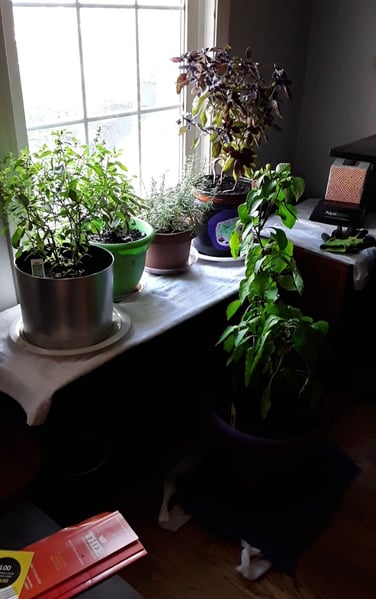It's finally gardening season! I started a garden for the first time last year, and it grew to 26 potted plants growing on my balcony. I moved some inside for winter and a handful of the ones that stayed outside made it through the Chicago cold on their own. If you garden in an urban area, you're likely doing so in containers, so you'll need to know how to transplant your plants from inside to outside for the winter and then back outside for spring.

My plants indoors for the winter
Although we are anxious to get our gardens going as early as possible after a hard winter, it's important to wait until the weather is at least 50 degrees at night before moving your plants outdoors. Any temperatures lower than that can shock the plants and can be dangerous for them. All plants are different and need specific care, so be sure to research the type of plant to know the proper light, temperature and water level for it.
Some plants are tropical which means they not only love the high heat temperatures, they thrive in them. I'm pretty sure rosemary can survive the apocalypse. It is one of the few plants that can be in extremely low temperatures and still be fine! This herb is especially delicious in Chef Erin Patsiopoulos' Rosemary Lemon Shortbread.
When you transition your plants from indoors to outdoors and back again, it's important to do so gradually. Houseplants are at risk of scorching when outside, so gradually increase the intensity of the light they receive. The same principle goes for cooler temperatures, so go slowly. Put your plants in a shady spot outside during the day but carry them back inside at night for a couple of weeks to start.
If the plants need to be transplanted before being moved indoors for winter, it is best to do that a few weeks before the big move so the plants can start new root production. This will make the transition easier. Also consider that you might not want to transplant them again after they have been moved indoors, so plan accordingly for a size pot that will allow room for growth for 4 to 6 months.
Transplants for the winter
Let’s talk about how to transplant those seedlings into a larger pot.
1. Use fresh soil
There are multiple choices at your local hardware/garden store such as garden soil, vegetable and herb soil, top soil, indoor potting mix, and all-purpose, just to name a few. You can choose a soil specific for your needs or just get the all-purpose kind. Don't be afraid to try out different options until you find the best option for the garden you have created.
2. Use a larger pot
Fill between 1/4 and a 1/3 of the pot with the fresh soil. Wet the soil. Gently remove the plant from the pot it currently resides in. Place gently in new pot, fill the sides with soil then just top it off with new soil, no more than an inch or so.
3. Or even better, a garden plot
If you are lucky enough to have a garden plot, you will need to till the garden and add fresh soil to mix in. Tilling is actually a form of deep cultivation that is necessary when preparing a new garden bed or when adding large amounts of organic material. Tilling will cultivate the soil 8-10 inches deep, perhaps even more if you are creating a new garden bed in an area where the soil is very poor, like my mom does for her garden in Las Vegas. As you till it will be beneficial to add fresh soil to mix in. After you till, add a fresh layer of top soil. Then dig a hole 6 to 8 inches deep to transplant larger seedlings or plants from the previous year.
My mom's garden in Las Vegas right after transplanting
My mom's garden in Las Vegas today
I'm excited to announce that this month, The Chopping Block will be starting a garden on our outdoor patio at Lincoln Square. After the garden starts thriving, we'll be able to offer fresh hand-picked herbs in the recipes we make in our cooking classes there. I'd love to see us be able to offer a class on how to cook foods produced in the garden one day.
In the meantime, don't miss our chef demonstration each Thursday at 6pm at the Lincoln Square Farmers Market. Each week our chef will shop from the market and show you how to make a delicious dish utilizing fresh produce and products from local farmers. You get a tasting of the dish and the recipe emailed to you so you can recreate it at home!
